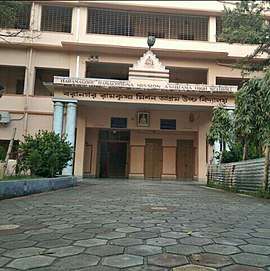Fort William, India
Fort William is a fort in Hastings, Calcutta (Kolkata). It was built during the early years of the Bengal Presidency of British India. It sits on the eastern banks of the Hooghly River, the major distributary of the River Ganges. One of Kolkata's most enduring Raj-era edifices, it extends over an area of 70.9 hectares.
| Fort William | |
|---|---|
| Kolkata, India | |
 Fort William, a view from the inside, c. 1828 | |
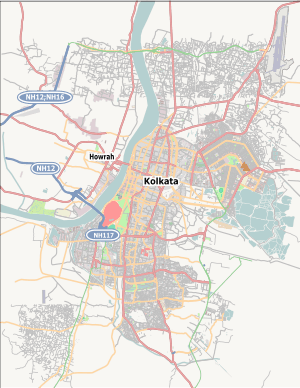 Fort William | |
| Coordinates | 22.5577°N 88.3380°E |
| Type | Fortress, garrisoned and armoured Army Headquarters. |
| Site information | |
| Controlled by | British East India Company Siraj Ud Daulah Indian Army (Current) |
| Site history | |
| Built | 1696-1702 |
| In use | 1781 - present |
| Battles/wars | Battle of Plassey |
| Garrison information | |
| Garrison | Eastern Command |
The fort was named after King William III.[1] In front of the Fort is the Maidan, the largest park in the city. An internal guard room became the Black Hole of Calcutta.
History
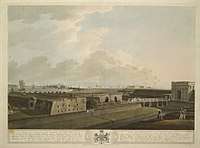
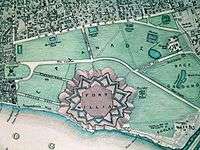
There are two Fort Williams. The original fort was built in the year 1696 by the British East India Company under the orders of Sir John Goldsborough which took a decade to complete. The permission was granted by Mughal Emperor Aurangzeb.[2][3] Sir Charles Eyre started construction near the bank of the Hooghly River with the South-East Bastion and the adjacent walls. It was named after King William III in 1700. John Beard, Eyre's successor, added the North-East Bastion in 1701, and in 1702 started the construction of the Government House (Factory, see Factory (trading post)) at the centre of the fort. Construction ended in 1706. The original building had two stories and projecting wings. In 1756, the Nawab of Bengal, Siraj Ud Daulah, attacked the Fort, temporarily conquered the city, and changed its name to Alinagar. This led the British to build a new fort in the Maidan.
Robert Clive started rebuilding the fort in 1758, after the Battle of Plassey (1757); construction was completed in 1781 at a cost of approximately two million pounds. The area around the Fort was cleared, and the Maidan became "the Lungs of Kolkata". It stretches for around 3 km in the north-south direction and is around 1 km wide.
The Old Fort was repaired and used as a customs house from 1766 onwards.
Today, Fort William is the property of Indian Army. The headquarters of Eastern Command is based there, with provisions for accommodating 10,000 army personnel. The Army guards it heavily, and civilian entry is restricted.
Much of Fort William is unchanged, but St Peter's Church, which used to serve as a chaplaincy centre for the British citizens of Kolkata, is now a library for the troops of HQ Eastern Command.
A war memorial has been created at the entrance of the fort, and the fort also houses a museum which displays artifacts from the Indo-Pakistani War of 1971, especially those related to the battles in the Eastern sector and the Bangladesh Liberation War.[4][5]
Presidency of Fort William
Structure
The Fort is built of brick and mortar in the shape of an irregular octagon with an area 5 km². Five of its sides face landward, and three towards the Hooghly River. The design is that of a star fort, suited to defence against cannon firing solid shot, and dates from before the advent of explosive shells. A dry moat 9 m deep and 15 m broad surrounds the fort. The moat can be flooded but is designed as an area in which to use enfilade (or "flanking") fire against any attackers reaching the walls. There are six gates: Chowringhee, Plassey, Calcutta, Water Gate, St Georges and the Treasury Gate. There are similar forts at places like Thalassery in Kerala.[6]
Gallery
 Fort William 1735
Fort William 1735 Fort William, Calcutta, 1756[7]
Fort William, Calcutta, 1756[7]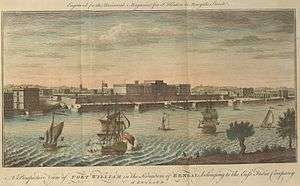 Fort William 1760
Fort William 1760.jpg) First English Chapel, Fort William, Calcutta. Raised in 1714, with contribution of Rs. 1000 by the East India Company (p. 197, March 1824)[8]
First English Chapel, Fort William, Calcutta. Raised in 1714, with contribution of Rs. 1000 by the East India Company (p. 197, March 1824)[8] St Peter's Church, Fort William by William Prinsep 1835
St Peter's Church, Fort William by William Prinsep 1835 The interior of the Arsenal, Fort William by William Prinsep 1835
The interior of the Arsenal, Fort William by William Prinsep 1835- Main entrance, Fort William 2013
- South gate, Fort William 2013
 St. Peter's Church, Fort William, Kolkata
St. Peter's Church, Fort William, Kolkata Semaphore Tower, Fort William, Kolkata
Semaphore Tower, Fort William, Kolkata
See also
References
| Wikimedia Commons has media related to Fort William (Kolkata). |
- Krishna Dutta (2003). Calcutta: A Cultural and Literary History. p. 71. ISBN 9781902669595.
- Sudip Bhattacharya, Unseen Enemy: The English, Disease, and Medicine in Colonial Bengal, 1617 – 1847, Cambridge Scholars Publishing, 30 Jun 2014, p.54
- "Fort William Kolkata India - History of Fort William". www.makemytrip.com. Retrieved 27 December 2018.
- "Memories of 1971 Bangladesh War come alive in Army museum". Economic Times. 16 December 2013.
- "Indian Army to throw parts of Eastern Command HQ open for public". Economic Times. 17 December 2013.
- Nandakumar Koroth, History of Forts in North Malabar
- Grant, James (1873). British Battles On Land and Sea. Volume II. Cassell & Company, Limited. p. 69.
- "The Gentleman's Magazine, and Historical Chronicle". The Gentleman's Magazine, and Historical Chronicle. 94 (1): 197. February 1824. Retrieved 13 December 2017.
